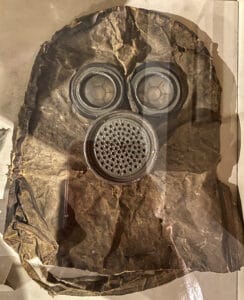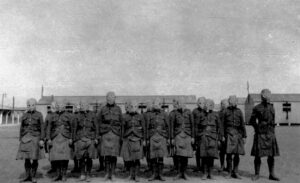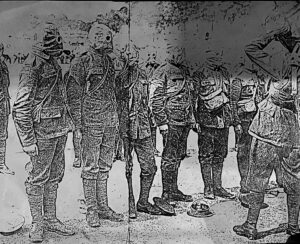Early World War 1 gas mask designed for use for hospital patients situated near the front lines where gas attacks were imminent. They were made up of the constituents of the “Model 17 Ledermasken” that is, the lenses with reinforcing “spiders” and the later war 17 “third model” filter canister. The hood-like design allowed for the mask to be slipped over the heads of the patients that were lying prone on cots or beds and prevent the mask from sliding off. They were usually tied around the neck with an attached cloth lace or string.
In August 1916, a new gas mask version inspired by the German WW1 gas mask units was engineered, and produced in January 1917. Though, its usage only started in January 1918. This new mask called ARS mask (special respiratory device) or MCG (chemical warfare mask) was at that time the best protective unit against gases the Allied soldiers had to face. Breathing is made safe through air purifying cartridges for an efficient protection. The ARS well covered the face thanks to adjustable elastic straps and offers a good protection to eyes and breathing system. As it evolved, this mask used several filter types including filtering cartridges filled with agglomerated coal and glycerin water.
This mask was of fragile construction, required excess training to use effectively and largely immobilized men during a gas attack as they were concerned about their mask coming loose.
The German army used poison gas for the first time against Allied troops at the Second Battle of Ypres, Belgium on April 22, 1915. As an immediate response, cotton wool wrapped in muslin was issued to the troops by 1 May and followed by the Black Veil Respirator, a cotton pad soaked in an absorbent solution which was secured over the mouth using black cotton veiling. Seeking to improve on the Black Veil respirator, Macpherson created a mask made of chemical absorbing fabric and which fitted over the entire head. A 19.9” × 18.9” canvas hood treated with chlorine-absorbing chemicals, and fitted with a transparent mica eyepiece. Macpherson presented his idea to the War Office Anti-Gas Department on May 10, 1915, with prototypes being developed soon after. The design was adopted by the British Army and introduced as the British Smoke Hood in June 1915; Macpherson was appointed to the War Office Committee for Protection against Poisonous Gases. More elaborate sorbent compounds were added later to further iterations of his helmet (PH helmet), to defeat other respiratory poison gases used such as phosgene, diphosgene and chloropicrin.



